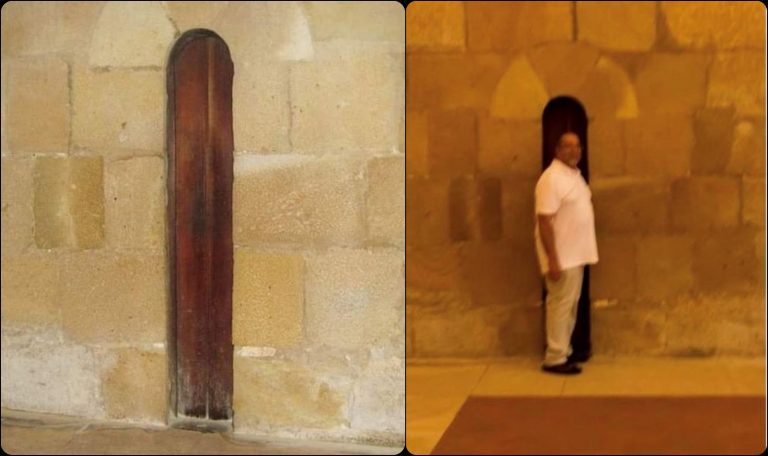ΚΥΚΛΟΦΟΡΕΙ ΕΥΡΥΤΑΤΑ ΣΤΟ ΔΙΑΔΙΚΤΥΟ ΤΟ ΑΚΟΛΟΥΘΟ ΚΕΙΜΕΝΟ ΤΗΣ "ΜΗΧΑΝΗΣ ΤΟΥ ΧΡΟΝΟΥ"
Γιατί η πόρτα της φωτογραφίας είναι τόσο στενή;
Βρίσκεται στο ρωμαιοκαθολικό μοναστήρι γοτθικού ρυθμού Αλκομπάσα (Alcobaça) της Πορτογαλίας, αποτελεί την είσοδο της κουζίνας και το πλάτος της είναι μόλις 32 εκατοστά.
H πόρτα της φωτογραφίας δεν είναι αποτέλεσμα μοντάζ. Είναι πράγματι στενή και συνήθως χαρακτηρίζεται ως
«αντι-λαιμαργική».
**********************************
ΠΡΟΣΟΧΗ
Η ΠΑΡΑΓΡΑΦΟΣ ΑΠΟ ΤΟ ΑΡΘΡΟ ΤΗΣ "ΜΗΧΑΝΗΣ ΤΟΥ ΧΡΟΝΟΥ" ΠΟΥ ΘΑ ΔΙΑΒΑΣΕΤΕ ΠΑΡΑΚΑΤΩ ΕΙΝΑΙ
FAKE NEWS
Η πόρτα ήταν ένας απλός και αποτελεσματικός τρόπος για να διατηρούνται οι μοναχοί σε ένα συγκεκριμένο βάρος, καθώς καλούνταν να περάσουν μέσα από αυτή, για να λάβουν το φαγητό τους από την κουζίνα και να το σερβίρουν στην τραπεζαρία. Αν κάποιος μοναχός δεν μπορούσε να περάσει, απαγορευόταν να φάει μέχρι να αποκτήσει ξανά το κατάλληλο βάρος.

H πόρτα της φωτογραφίας δεν είναι αποτέλεσμα μοντάζ. Είναι πράγματι στενή και συνήθως χαρακτηρίζεται ως «αντι-λαιμαργική».
Βρίσκεται στο ρωμαιοκαθολικό μοναστήρι γοτθικού ρυθμού Αλκομπάσα (Alcobaça) της Πορτογαλίας, αποτελεί την είσοδο της κουζίνας και το πλάτος της είναι μόλις 32 εκατοστά.
Η είσοδος της μονής φέρει την επιγραφή: "Σκεφτείτε ότι τρώτε τις αμαρτίες των ανθρώπων", γεγονός που προϊδεάζει τους ανυποψίαστους επισκέπτες για τον πραγματικό λόγο που οι διαστάσεις της είναι τόσο μικρές. Aπό την ίδρυσή του το μοναστήρι συνδέθηκε με το Τάγμα των Κιστερνιακών.
Οι Κιστερκιανοί είναι μικτό θρησκευτικό, μοναστικό τάγμα της Ρωμαιοκαθολικής Εκκλησίας γνωστό και ως «Λευκοί Μοναχοί» ή «Οι Βερναρδίνοι». Ακολουθούσαν ευλαβικά τους «αρχικούς κανόνες» του Αγίου Βενέδικτου, οι οποίοι ανάμεσα στην χειρωνακτική εργασία και την ανά διαστήματα υποχρεωτική σιωπή, όριζαν και την αυστηρή νηστεία
Λέγεται ότι οι Κιστερκιανοί ήταν στην πλειοψηφία τους αγρότες, που κατανάλωναν ό,τι παρήγαγαν και συνήθως είχαν στη διάθεσή τους πολλά τρόφιμα.
ΠΡΟΣΟΧΗ
Η ΠΑΡΑΓΡΑΦΟΣ ΑΠΟ ΤΟ ΑΡΘΡΟ ΤΗΣ "ΜΗΧΑΝΗΣ ΤΟΥ ΧΡΟΝΟΥ" ΠΟΥ ΘΑ ΔΙΑΒΑΣΕΤΕ ΠΑΡΑΚΑΤΩ , ΣΤΗ ΣΥΝΕΧΕΙΑ ΤΟΥ ΑΡΘΡΟΥ, ΕΙΝΑΙ
FAKE NEWS
Η πόρτα ήταν ένας απλός και αποτελεσματικός τρόπος για να διατηρούνται οι μοναχοί σε ένα συγκεκριμένο βάρος, καθώς καλούνταν να περάσουν μέσα από αυτή, για να λάβουν το φαγητό τους από την κουζίνα και να το σερβίρουν στην τραπεζαρία. Αν κάποιος μοναχός δεν μπορούσε να περάσει, απαγορευόταν να φάει μέχρι να αποκτήσει ξανά το κατάλληλο βάρος.
Η λαιμαργία θεωρείτο θανάσιμη αμαρτία.
To ρωμαιοκαθολικό μοναστήρι Alcobaca στην Πορτογαλία, όπου βρίσκεται η «αντι-λαιμαργική» πόρτα. Είναι το πρώτο κτήριο γοτθικού ρυθμού στην Πορτογαλία (Πηγή: Wikipedia)
Ο ταξιδιωτικός συγγραφέας Ουίλιαμ Μπέκφορντ που επισκέφτηκε το μοναστήρι τον 18ο αιώνα, όταν ακόμα ίσχυε «ο κανόνας της πόρτας», εντυπωσιάστηκε με τα πλουσιοπάροχα εδέσματα της μονής. «Υπάρχουν πολλά κρέατα, φρούτα και λαχανικά σε ατελείωτες ποικιλίες.
»Μετά τις σόμπες υπάρχουν φούρνοι και λόφοι από σιτάρι, από αλεύρι που είναι πιο λευκό από το χιόνι, βράχοι ζάχαρης, βάζα με το πιο αγνό λάδι και γλυκά σε μεγάλη αφθονία, τα οποία ξεδίπλωνε σε εκατό διαφορετικά σχήματα μια ομάδα μοναχών, τραγουδώντας τόσο απαλά όσο τα πουλιά στα χωράφια».
Όταν δοκίμασε μάλιστα από τα παραπάνω εδέσματα, περιέγραψε, «το τραπέζι δεν είχε μόνο τα πιο εξαιρετικά εδέσματα, αλλά και τις πιο σπάνιες λιχουδιές περασμένων εποχών και μακρινών χωρών.
»Εξαίσια λουκάνικα, λάμπραινες στη γάστρα, παράξενα πιάτα από την Βραζιλία και την Κίνα, όπως φωλιές πτηνών και πτερύγια καρχαρία. Τα γλυκά και τα φρούτα μας περίμεναν σε ένα διπλανό ακόμα πιο ευρύχωρο και πολυτελή χώρο, στον οποίο αποσυρθήκαμε υπό την επίδραση του φαγητού».
Σήμερα, το μοναστήρι αποτελεί Μνημείο Παγκόσμιας Κληρονομιάς της UNESCO.
Πηγή: mixanitouxronou
___________________________
H AΛΗΘΕΙΑ ΓΙΑ ΤΗ ΣΤΕΝΗ ΠΟΡΤΑ ΤΟΥ ΜΟΝΑΣΤΗΡΙΟΥ ΕΙΝΑΙ ΑΥΤΗ
NOT a monastery’s ’Anti-Gluttony door’
The Alcobaça Monastery has a rather narrow door in its former dining
hall, according to social media posts this is the “anti gluttony door”.
Monks
who had to fetch their own food from the kitchen could only fit through
the door if they weren’t eating too much as the passage is only 32cm
(roughly 1 foot) wide.
If they couldn’t get through, they wouldn’t get any food.
To
prove the claim the story is often accompanied with a picture of a
gentleman with a bit of a belly who seems to be unable to get though the
door.
The narrow door at the Monastery in Alcobaça is in reality 50
centimetres (1.6 ft) wide but was meant to pass plates from the kitchen
to the refectory.
In a way it was just an early version of the serving hatch.
In 2008 a photo of the door was uploaded to wikipedia commons with the description; “ Mosteiro de Alcobaça, Refectory, door of unknown usage, said being used for monk´s weight-control”.

Portuguese Wikipedia used the picture for the page on the monastery as “The legendary narrow door of the cafeteria, which was intended to deliver meals to the poor.”.

In 2014 a user by the name Daniel Villafruela uploaded the picture of the man unable to fit through the door with the caption ‘I fear to have severely violated the Rule of frugality’.

But the myth may have been older and was perhaps already being told by tour-guides long before this time.
Many
myths are born thanks to a guide who decided to be a bit creative with
the truth or who forgot to mention that the story he keeps telling the
tourists was nothing more than a fable.
Monks have been made fun of and accused of living the good life for centuries, even in medieval times they were a popular target for mocking and there are countless stories of fat monks who drank, ate and fornicated too much.
And although this undoubtedly happened in some cases, the men at the Alcobaça monastery were Cistercian monks and thus had a strict, generally healthy diet.
Even if one of the monks got a bit too rotund, there surely would be
easier ways to make him eat a bit less than to have an architect plan a
special door just for these rare occasions.
Besides if a monk is
peckish he’ll find a way, especially as there’s another door to the
kitchen just left of it that is so wide it would fit several monks at
once.

Google Maps has a wonderful virtual tour of the stunning monastery you can easily find online (or click here), you can see both the doors next to each other.
Of course that door is never on the photo’s being shared to accompany this story.
The real function for the door is that of a serving hatch, on the other side of the wall was indeed once the kitchen and plates would be passed through.
This is of course a much less entertaining story and it is less fun to imagine someone handing a plate of food than a sad looking monk trying to fit through the door while his brothers try not to laugh.
That is probably why the story is still being taught at the monastery even they do mention that it is not true.
The ‘guião de visita‘ (visitor’s guide) that can be found on the monastery’s official website says;
“Look at the narrowest door! It’s called “dish-carrier” and was used to pass the dishes and food to the cafeteria. There is a legend regarding to this door, which says that the monks who could not pass through it were considered sinners because they were very fat.“

It is unclear why they put in such a tall door in stead of just a
little window, even if you stack a lot of plates, the passage wouldn’t
have needed it to be as big as it is.
I think it may be because it was also used to pass large trays vertically and perhaps even trestle tables.

Good example of a trestle table.
On the other hand the place was rebuild and altered countless times during it’s history, in the 1840s the refectory was even turned into a theatre hall.
Sources;






Δεν υπάρχουν σχόλια:
Δημοσίευση σχολίου